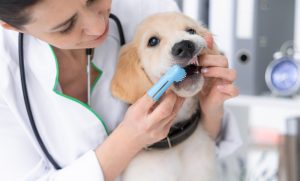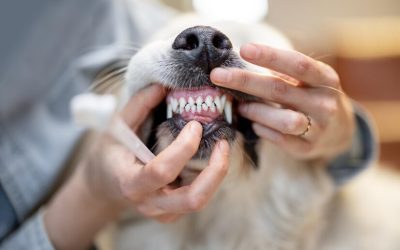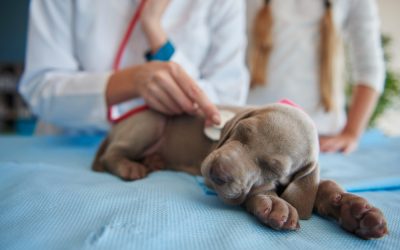Why Does My Dog’s Breath Smell So Bad?

Bad breath in dogs can put a damper on those sweet puppy kisses, but understanding the causes and taking steps to address it can make a big difference! While it’s normal for a dog to have some bad breath, persistent foul odors could indicate something more serious, like dental issues or other health concerns. Here’s how to ensure your pup’s mouth stays fresh and healthy.
Understanding the Causes of Bad Breath in Dogs
Doggy breath, or canine halitosis, is something every pet parent has encountered. While occasional bad breath isn’t usually a concern, constant foul odors might signal underlying problems. Here are some common culprits:
- Dental Disease: Plaque and tartar buildup can lead to gum inflammation, tooth decay, and even infections, causing smelly breath.
- Oral Infections: Abscesses, cysts, or even tumors can create an environment for bacteria to thrive, leading to bad breath.
- Metabolic Issues: Conditions like diabetes or kidney disease can cause an accumulation of waste products in the blood, which may result in bad breath.
- Diet: High-protein or low-fiber diets can also contribute to smelly breath, as the breakdown of these nutrients produces foul-smelling compounds.
Common Dental Problems That Cause Bad Breath
A number of dental issues can contribute to bad breath. The most common include:
- Periodontal Disease: This progressive condition begins with plaque buildup and, if untreated, can lead to tooth loss.
- Tooth Decay: Cavities can develop when bacteria in the mouth produce acids that erode the enamel and create holes in the teeth.
- Oral Tumors: Growths in the mouth can cause inflammation, infection, and bad breath.
- Fractured Teeth: Broken or cracked teeth can expose the inner pulp, which may lead to infection and unpleasant odors.
How to Get Rid of Your Dog’s Bad Breath
As Riley Shugg, MS, DVM stated in the article:
‘’If your dog has bad breath, your first step is to schedule a dental exam. If you allow a veterinary professional to routinely exam your dog’s mouth, they can detect dental disease and other health issues earlier.
If your dog is prone to periodontal disease, routine cleaning may be needed to help prevent excessive tartar formation and frequent dental extractions (having teeth pulled).
Here are some other ways to improve your dog’s oral health and keep their breath smelling better:
- Regular Brushing: Weekly to daily brushing with canine toothpaste and toothbrushes can be the most effective way to prevent plaque formation. Many dog toothpastes are flavored to be enticing to dogs.
- Dental Treats and Products: Dental treats can either help physically remove plaque as your dog chews or may contain additives that promote a healthy oral environment. Other products like dental water additives can be used to help mask bad breath as well as promote oral health. These are typically unflavored, and you simply add a small amount to your pet’s water dish each day.
- Dental Diets: There are dental diets made for dogs that can help reduce plaque buildup. They use a larger kibble size and a course texture to scrape along the tooth and remove plaque as your dog chews.’’
How to Prevent Bad Breath in Your Dog
Here are some easy ways to prevent bad breath:
- Brush Regularly: Just like humans, dogs benefit from regular tooth brushing. Aim for a few times a week using dog-safe toothpaste.
- Offer Dental Chews: Special dental chews help scrape away plaque and tartar as your dog chews. Look for approved products from the Veterinary Oral Health Council (VOHC).
- Raw Meaty Bones: Raw bones can naturally clean your dog’s teeth under supervision.
- Try Dental Wipes or Pads: Dental wipes can be a great alternative if brushing is a struggle.
- Provide Plenty of Chew Toys: Chew toys promote healthy gums and help remove plaque.
How Can Pet Insurance Help You if Your Dog Needs a Treatment?
Pet insurance can be a valuable tool in managing the costs of treating a dog’s veterinary expenses. By having a pet insurance policy in place, you can have peace of mind knowing that you can provide medical care for your furry companion without worrying about the financial burden. Pet insurance can help cover the costs of veterinary consultations, diagnostic tests, medications, and even specialized treatments if required.
Reimbursement
This method is the most common for pet insurance companies. You pay out of pocket for the veterinarian bill, and then the insurance company reimburses you for what’s covered under the insurance plan. The steps look like this.
- You pay the vet bill after your dog’s visit.
- You fill out the pet insurance claim form.
- Submit the claim form and other required documentation to the insurer.
- After the claim is approved, you will be reimbursed for eligible expenses.
What Does Odie Pet Insurance Cover?
Pet insurance covers various veterinary expenses, providing financial protection and peace of mind for pet owners. Here are the details of the coverage options offered by Odie Pet Insurance:
Illness & Injury Plan
The Illness & Injury Plan is an all-inclusive insurance plan designed to cover a wide range of medical needs for your pet. This plan includes comprehensive coverage for various illnesses, injuries, and veterinary services. Some of the covered items include:
- Veterinary exams and consultations
- Diagnostics (e.g., X-rays, lab tests)
- Prescribed medications
- Surgeries and hospitalization
- Rehabilitation, acupuncture, or chiropractic treatments
- Medically necessary supplies
- Euthanasia and cremation
The Wellness Plan
The Wellness Plan is a monthly membership that focuses on preventive care and covers routine veterinary services.
- Provides reimbursements for routine care items such as wellness visits (exams and vaccines), testing and parasite prevention, dental cleanings and at-home dental care, vitamins, supplements, and more.
- Through Odie’s partnership with Petivity, a leader in smart pet products and proactive care, Wellness Plan members can also receive reimbursements for Petivity devices and health kits, as well as eligible Purina food and supplements.
- Total reimbursement up to $700 per year.




